Abstract
1 Seventeen patients with rheumatoid arthritis were studied in a double-blind crossover trial contrasting three different times of administration of twice-daily flurbiprofen. 2 Twelve of these patients were also studied when taking the same dose of flurbiprofen as a split dose four times a day. 3 Symptoms and signs of the disease were self-assessed throughout the day for several days on each regimen and the information was analysed for rhythmicity. 4 Twice a day flurbiprofen may be more effective than four times daily flurbiprofen, and the regimen without an evening dose was the least effective of three twice-daily treatments tested. 5 Circadian rhythms of grip strength and finger joint size were demonstrated, and were similar on all treatment regimens. 6 These rhythms have a similar pattern to those detected during studies of immune responses, and it is suggested that morning stiffness in rheumatoid arthritis is not only the result of nocturnal inactivity, and may respond to appropriately timed medication given to decrease inflammation or to suppress other aspects of the immune response.
Full text
PDF
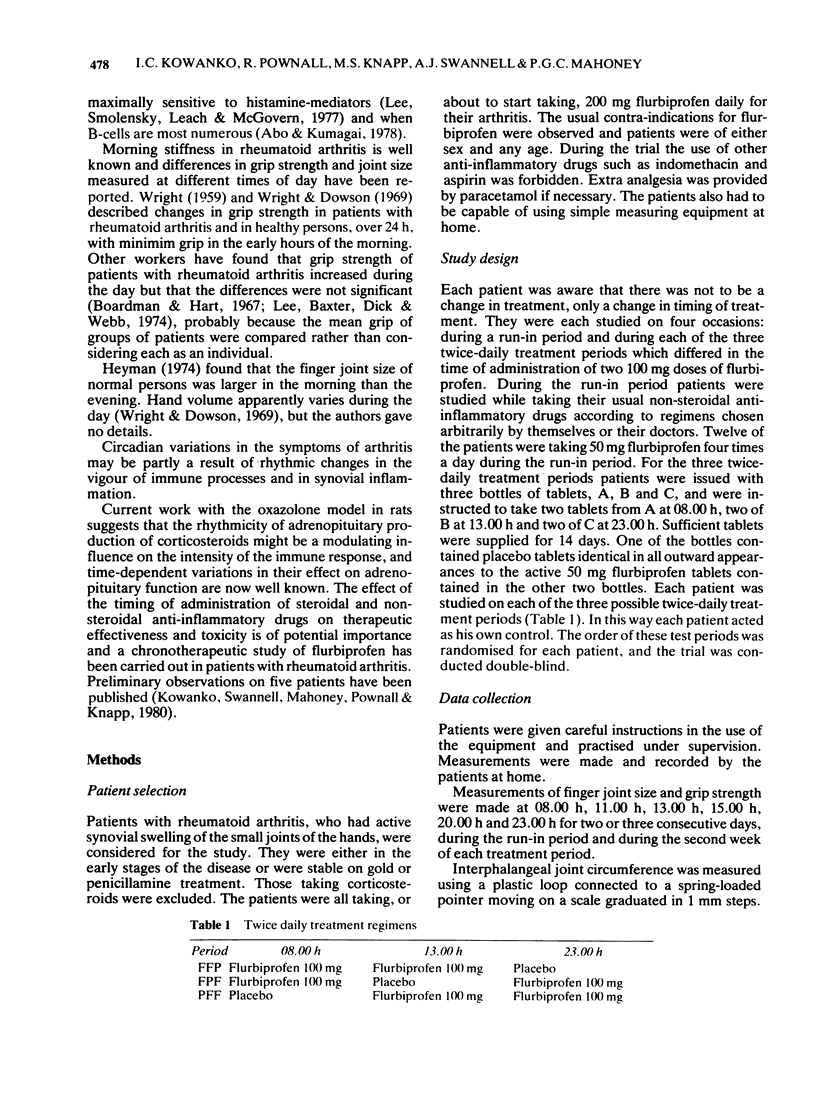
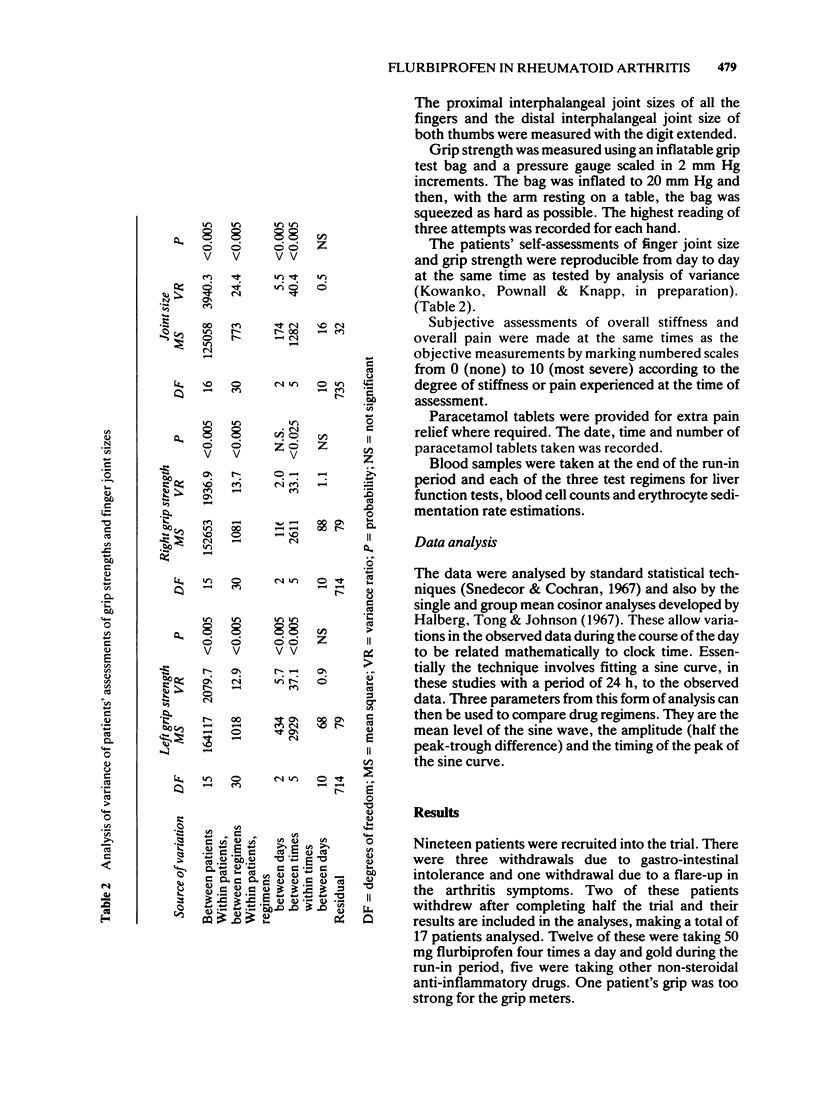

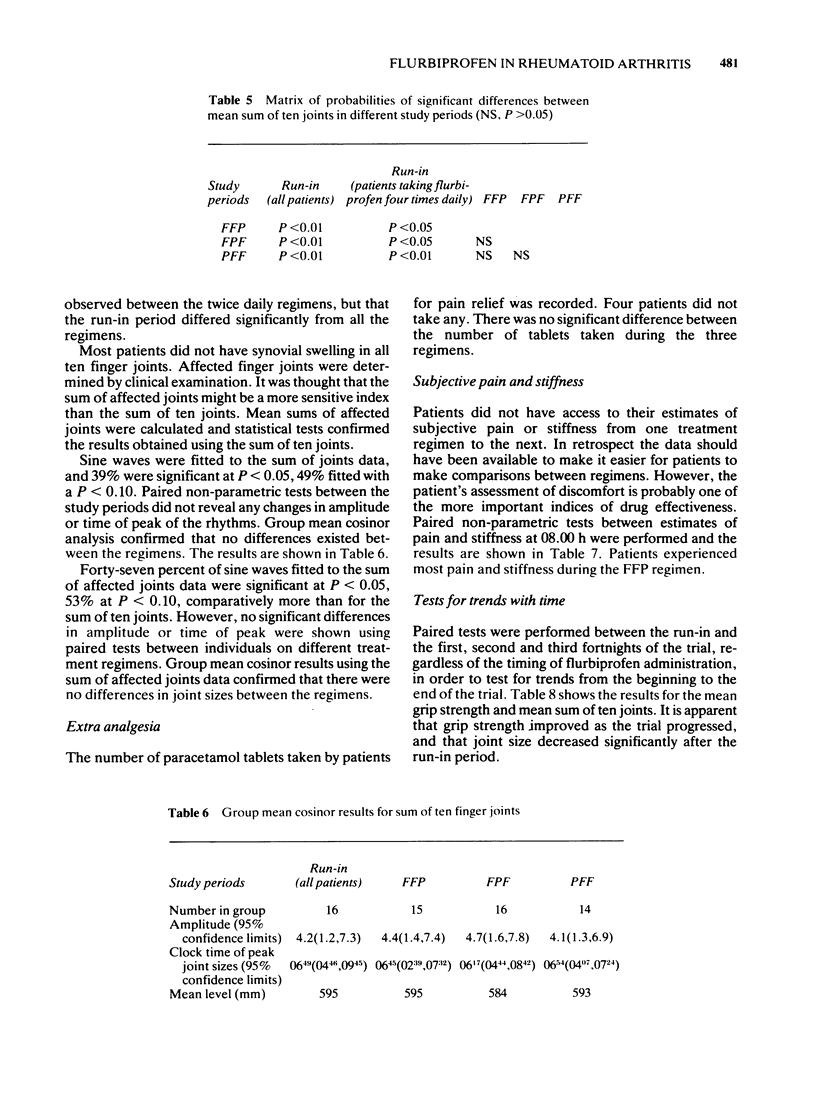
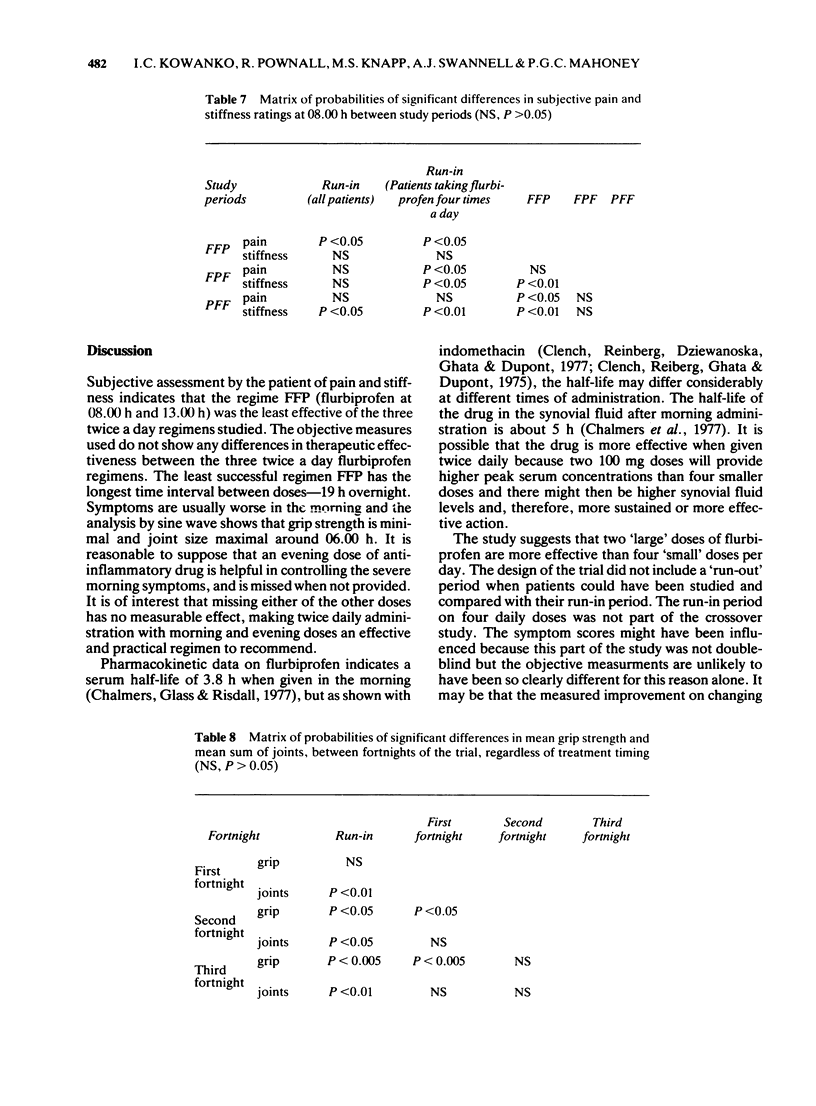
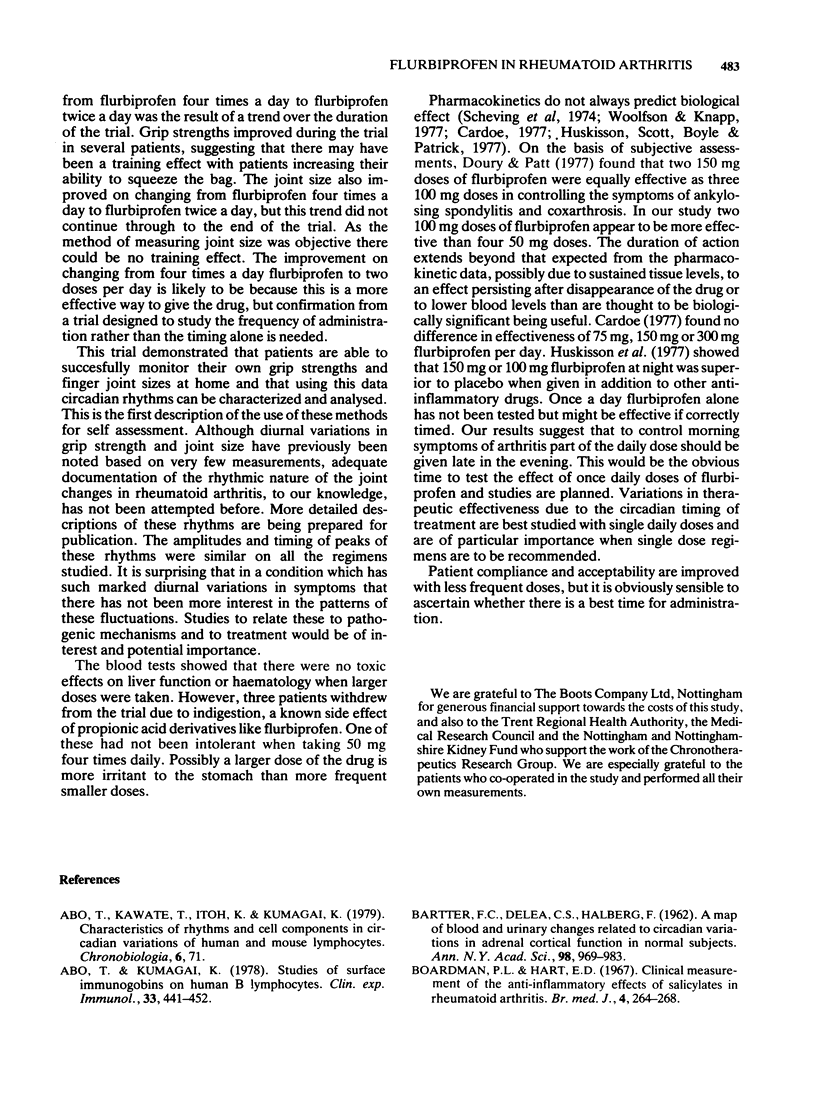
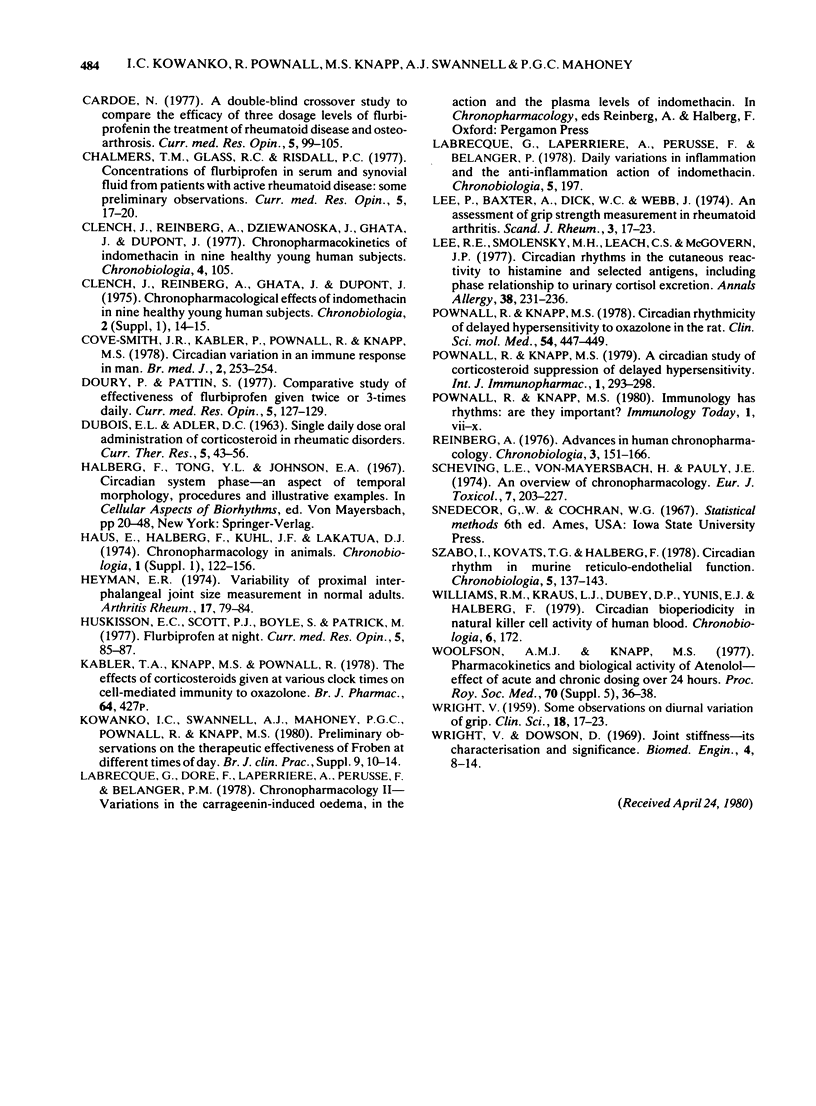
Selected References
These references are in PubMed. This may not be the complete list of references from this article.
- Abo T., Kumagai K. Studies of surface immunoglobulins on human B lymphocytes. III. Physiological variations of SIg+ cells in peripheral blood. Clin Exp Immunol. 1978 Sep;33(3):441–452. [PMC free article] [PubMed] [Google Scholar]
- BARTTER F. C., DELEA C. S. A map of blood and urinary changes related to circadian variations in adrenal cortical function in normal subjects. Ann N Y Acad Sci. 1962 Oct 30;98:969–983. doi: 10.1111/j.1749-6632.1962.tb30612.x. [DOI] [PubMed] [Google Scholar]
- Boardman P. L., Hart F. D. Clinical measurement of the anti-inflammatory effects of salicylates in rheumatoid arthritis. Br Med J. 1967 Nov 4;4(5574):264–268. doi: 10.1136/bmj.4.5574.264. [DOI] [PMC free article] [PubMed] [Google Scholar]
- Cardoe N. A double-blind crossover study to compare the efficacy of three dosage levels of flurbiprofen in the treatment of rheumatoid disease and osteoarthrosis. Curr Med Res Opin. 1977;5(1):99–105. doi: 10.1185/03007997709108985. [DOI] [PubMed] [Google Scholar]
- Chalmers T. M., Glass R. C., Risdall P. C. Concentrations of flurbiprofen in serum and synovial fluid from patients with active rheumatoid disease: some preliminary observations. Curr Med Res Opin. 1977;5(1):17–20. doi: 10.1185/03007997709108970. [DOI] [PubMed] [Google Scholar]
- Cove-Smith J. R., Kabler P., Pownall R., Knapp M. S. Circadian variation in an immune response in man. Br Med J. 1978 Jul 22;2(6132):253–254. doi: 10.1136/bmj.2.6132.253. [DOI] [PMC free article] [PubMed] [Google Scholar]
- Doury P., Pattin S. Comparative study of the effectiveness of flurbiprofen given twice or 3-times daily. Curr Med Res Opin. 1977;5(1):127–129. doi: 10.1185/03007997709108989. [DOI] [PubMed] [Google Scholar]
- Haus E., Halberg F., Kühl J. F., Lakatua D. J. Chronopharmacology in animals. Chronobiologia. 1974 Sep;1 (Suppl 1):122–156. [PubMed] [Google Scholar]
- Heyman E. R. Variability of proximal interphalangeal joint size measurements in normal adults. Arthritis Rheum. 1974 Jan-Feb;17(1):79–84. doi: 10.1002/art.1780170112. [DOI] [PubMed] [Google Scholar]
- Huskisson E. C., Scott P. J., Boyle S., Patrick M. Flurbiprofen at night. Curr Med Res Opin. 1977;5(1):85–87. doi: 10.1185/03007997709108982. [DOI] [PubMed] [Google Scholar]
- Kabler T. A., Knapp M. S., Pownall R., Bennett T. The effects of corticosteroids given at various clock times on cell-mediated immunity to oxazolone [proceedings]. Br J Pharmacol. 1978 Nov;64(3):427P–427P. [PMC free article] [PubMed] [Google Scholar]
- Lee P., Baxter A., Dick W. C., Webb J. An assessment of grip strength measurement in rheumatoid arthritis. Scand J Rheumatol. 1974;3(1):17–23. doi: 10.3109/03009747409165124. [DOI] [PubMed] [Google Scholar]
- Lee R. E., Smolensky M. H., Leach C. S., McGovern J. P. Circadian rhythms in the cutaneous reactivity to histamine and selected antigens, including phase relationship to urinary cortisol excretion. Ann Allergy. 1977 Apr;38(4):231–236. [PubMed] [Google Scholar]
- Pownall R., Knapp M. S. A circadian study of corticosteroid suppression of delayed hypersensitivity. Int J Immunopharmacol. 1979;1(4):293–298. doi: 10.1016/0192-0561(79)90005-5. [DOI] [PubMed] [Google Scholar]
- Pownall R., Knapp M. S. Circadian rhythmicity of delayed hypersensitivity to oxazolone in the rat. Clin Sci Mol Med. 1978 Apr;54(4):447–449. doi: 10.1042/cs0540447. [DOI] [PubMed] [Google Scholar]
- Reinberg A. Advances in human chronopharmacology. Chronobiologia. 1976 Apr-Jun;3(2):151–166. [PubMed] [Google Scholar]
- Schoeppe W. Effects of dopamine on kidney function. Proc R Soc Med. 1977;70 (Suppl 2):36–42. doi: 10.1177/00359157770700S207. [DOI] [PMC free article] [PubMed] [Google Scholar]
- Szabó I., Kovats T. G., Halberg F. Circadian rhythm in murine reticuloendothelial function. Chronobiologia. 1978 Apr-Jun;5(2):137–143. [PubMed] [Google Scholar]
- WRIGHT V. Some observations on diurnal variation of grip. Clin Sci. 1959 Feb;18(1):17–23. [PubMed] [Google Scholar]
- Wright V., Dowson D., Longfied M. D. Joint stiffness--its characterisation and significance. Biomed Eng. 1969 Jan;4(1):8–14. [PubMed] [Google Scholar]


